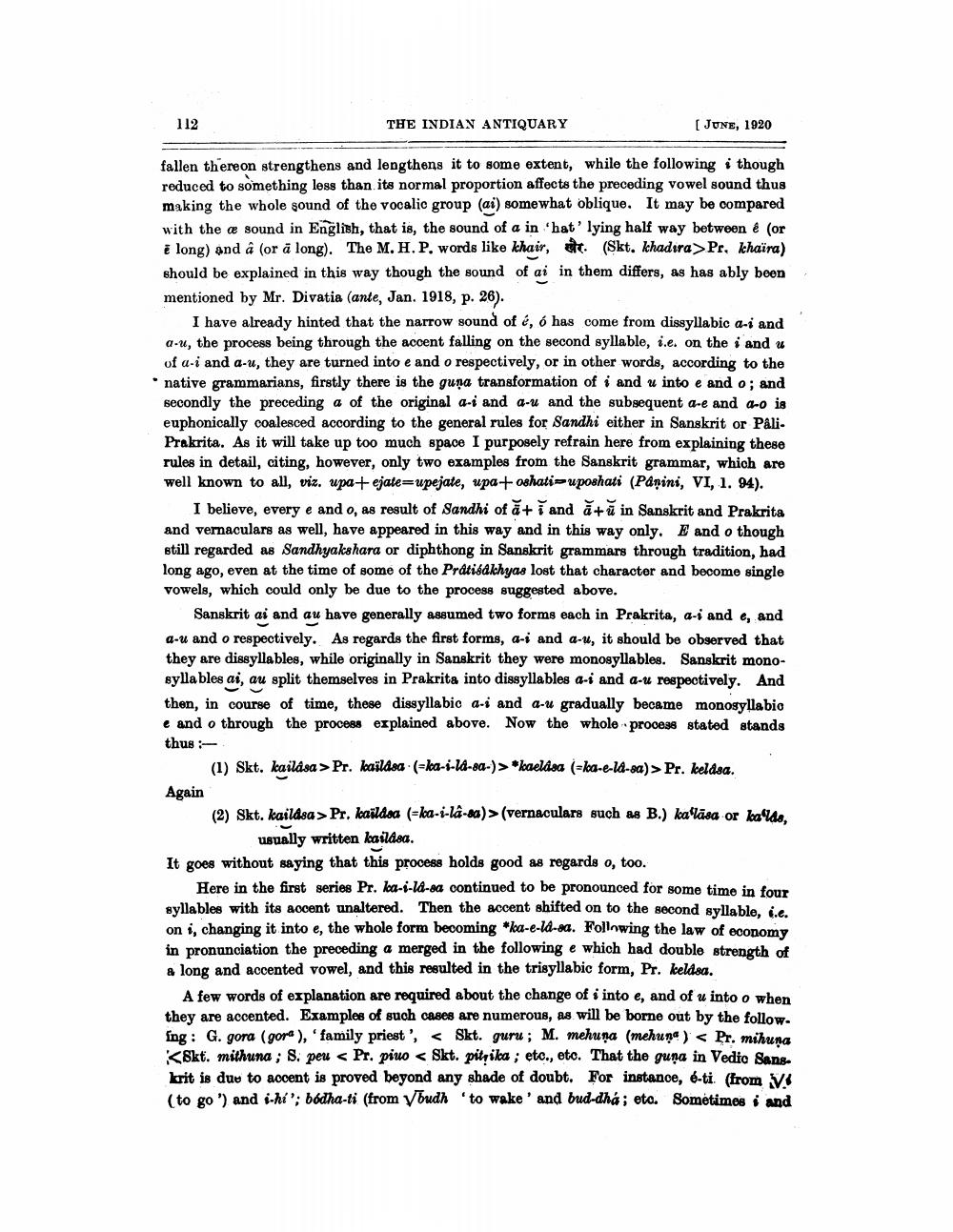________________
112
THE INDIAN ANTIQUARY
[JUNE, 1920
fallen thereon strengthens and lengthens it to some extent, while the following i though reduced to something less than its normal proportion affects the preceding vowel sound thus making the whole sound of the vocalic group (ai) somewhat oblique. It may be compared with the æ sound in English, that is, the sound of a in 'hat' lying half way between & (or i long) and a (or a long). The M. H.P. words like khair, . (Skt, khadira>Pr. khaïra) should be explained in this way though the sound of ai in them differs, as has ably been mentioned by Mr. Divatia (ante, Jan. 1918, p. 26).
I have already hinted that the narrow sound of é, ó has come from dissyllabic a-i and a-u, the process being through the accent falling on the second syllable, i.e. on the i and u of a-i and a-u, they are turned into e and o respectively, or in other words, according to the • native grammarians, firstly there is the guna transformation of i and u into e and o; and
secondly the preceding a of the original a-i and a-u and the subsequent a-e and a-o is euphonically coalesced according to the general rules for Sandhi either in Sanskrit or Pali. Prakrita. As it will take up too much space I purposely refrain here from explaining these rules in detail, citing, however, only two examples from the Sanskrit grammar, which are well known to all, viz. upa+ ejate=upejate, upa+oshatisuposhati (Panini, VI, 1. 94).
I believe, every e and o, as result of Sandhi of a + i and +ū in Sanskrit and Prakrita and vernaculars as well, have appeared in this way and in this way only. E and o though still regarded as Sandhyakshara or diphthong in Sanskrit grammars through tradition, had long ago, even at the time of some of the Prátisakchyas lost that character and become single vowels, which could only be due to the process suggested above.
Sanskrit ai and au have generally assumed two forms each in Prakrita, a-i and e, and a-u and o respectively. As regards the first forms, a-i and a-u, it should be observed that they are dissyllables, while originally in Sanskrit they were monosyllables. Sanskrit monosyllables ai, au split themselves in Prakrita into dissyllables a-i and a-u respectively. And then, in course of time, these diggyllabic a-i and a-u gradually became monosyllabio e and o through the process explained above. Now the whole process stated stands thus >
(1) Skt. kailasa > Pr. kaildsa (=ka-i-18-8a-) > kaelasa (=ka-e-id-sa) > Pr. keldsa. Again (2) Skt. kaildsa > Pr, kaildea (=ka-i-la-ra)>(vernaculars such as B.) katlāsa or kalas.
usually written kaildsa. It goes without saying that this process holds good as regards o, too.
Here in the first series Pr. la-1-18-aa continued to be pronounced for some time in four syllables with its accent unaltered. Then the accent shifted on to the second syllable, i.e. on i, changing it into e, the whole form becoming *ka-e-la-sa. Following the law of economy in pronunciation the preceding a merged in the following e which had double strength of a long and accented vowel, and this resulted in the trisyllabic form, Pr. keldsa.
A few words of explanation are required about the change of i into e, and of u into o when they are accented. Examples of such cases are numerous, as will be borne out by the follow. îng: G. gora (gora ), 'family priest', < Skt. guru; M. mehuņa (mehuna ) < Pr. minuna <<Skt. mithuna ; 8. peu < Pr. piuo < Skt. pityika ; etc., etc. That the guna in Vedio Sanskrit is due to accent is proved beyond any shade of doubt. For instance, é-ti. (from Vi (to go") and i-hi!; bódha-ti (from budh 'to wake' and bud-dha; eto. Sometimes i and




